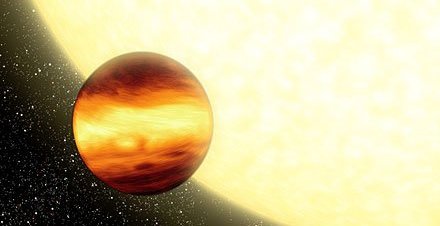
Artist’s impression of a giant exoplanet. (Courtesy: Spitzer Space Telescope).
By Hamish Johnston
About a month ago we reported that astronomers might be able find Earth-like exoplanets by studying the chemical signatures of distant stars.
The idea is that the formation of rocky planets such as Earth and Mars leave their companion stars deficient in heavy elements such as aluminium, iron and nickel. The team came to this conclusion after finding that the Sun seems to have about a 15% deficit in these elements compared to similar stars.
Now another group of astronomers has looked at the lithium content of Sun-like stars, and discovered that stars with exoplanets have less lithium than those with no exoplanets. It is already well known that the Sun has 140 times less lithium on its surface than predicted by models of solar evolution.
I spoke to one of the group — Garik Israelian of the Institute of Astrophysicists in the Canary Islands — and he told me that there are two mechanisms by which planet formation could lead to low levels of lithium.
The first is related to “giant migration”, whereby the orbits of Jupiter-like planets change over time. The resulting transfer of angular momentum can leave the lithium-rich outer atmosphere of the star spinning faster relative to the core of the star. This leads to turbulence, which sends some of the lithium deeper into the star where it is hot enough for it to burn via nuclear fusion.
The second is related to the fact that much of the angular momentum in a solar system is tied up in the planets — which means that the core of a star with planets is probably rotating much slower than a similar star with no planets. However, the atmosphere of such a star still rotates rapidly, leading to turbulence and lithium burning.
Indeed, both of these effects could act in succession on the same star – really setting its lithium ablaze.
Israelian believes that exoplanets could be behind the ‘lithium problem’ — the puzzling observation that stars of the same temperature, age and metallicity have very different levels of lithium.
The discovery could also help to further accelerate the discovery of exoplanets — about 400 have been found so far — by narrowing down the field of stellar candidates.
The research is reported in Nature 462 189.
If you want to know more about exoplanets, check out this article by Alan Boss.



